Mind Guerrilla
something to refresh the palate after our recent heavy discussions …
Mind-centered art
"One of Yoko Ono's most powerful childhood memories dates to the final months of World War II in Japan. The U.S. firebombings of Tokyo in March 1945 that left tens of thousands dead and the city a vast charred ruin had forced Yoko's mother to evacuate her family to the countryside for safety.
"Yoko remembers spending the afternoons hiding with her brother Keisuke from the irate and unbalanced world outside. "Lying on our backs, looking up at the sky through an opening in the roof, we exchanged menus in the air and used our powers of visualization to survive." The imaginary realm and the sky as a calling to vast, pale freedom would later become hallmarks of Ono's mind-centered art."
Alexandra Munroe
"Spirit of YES: The Art and Life of Yoko Ono"
in YES YOKO ONO
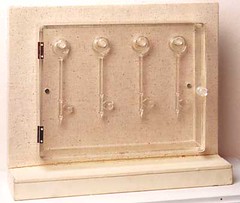
Water Event:
Yoko Ono wishes to invite you to participate in a water event by requesting you to produce with her a water sculpture, by submitting a water container or idea of one which would form half of the sculpture. Yoko will supply the other half — water. The sculpture will be credited as Water Sculpture by Yoko Ono and yourself. The sculpture will be displayed lasting the duration of the show.
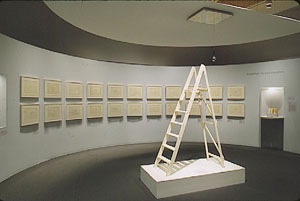
The viewer looked through the magnifying glass (hanging at the top of the ladder) at a painting of the word "YES" on the ceiling.
This is a historic piece in the lore of John and Yoko. Lennon saw it the first day he met Yoko and immediately "got" it. He was relieved to discover that Yoko had a positive message.
Go to Eros
fountain and
throw in all
your jewelleries.
London, Sept., 1966
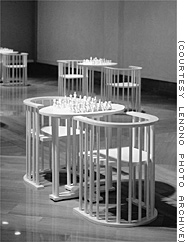
All the chess pieces and all the squares are white. Any piece can be moved to any square.
Sun Piece:
Watch the sun until it becomes square.
1962 winter
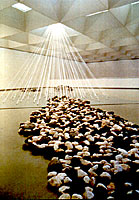
(In the background is Morning Beams)
Yoko allowed viewers to pick up and move the stones. Some installations had these instructions:
Make a numbered list of sadness in your life. Pile up stones corresponding to those numbers. Add a stone each time there is a sadness. Burn the list and appreciate the mound of stones for its beauty.
Make a numbered list of happiness in your life. Pile up the stones corresponding to those numbers. Add a stone each time there is a happiness. Compare the mound of stones to the one of sadness.
Painting to See the Skies:
Drill two holes into a canvas. Hang it where you can see the sky.
(Change the place of hanging. Try both the front and the rear windows, to see if the skies are different.)
1961 summer
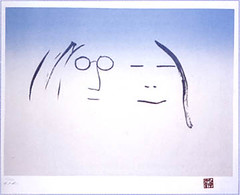
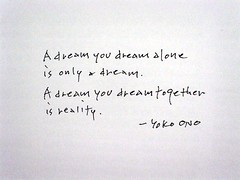
("Two Is One" sketch by John Lennon)
If you're wondering about the title, it comes from the lyrics to the John Lennon song, "Mind Games":
Pushing the barriers, planting seeds
Playing the mind guerrilla
Chanting the Mantra, peace on earth.
John and Yoko believed in the power of ideas and mental images to change the world: in particular, to conquer the world for peace. Hopelessly naive? Maybe, but name a better strategy. Changing institutions and structures will only take us so far. Ultimately, hope rests on changing how people think.
Glass keys to open the sky. Get it?


7 Comments:
The chessboard thing is particularly cool. I like the fact that most of the art is interactive. Thanks for sharing, q!
Interesting hiatus. Personally I have always thought that John and Yoko as individuals were over rated.
Neither struck me as remarkable outside of John's music. However, their limited ability to influence the world individually seems to be amplified as a couple. This is something that most people would disagree with but I have found a good article by John Tomson of worldsocialism.org who seems to share the same opinion.
Tomson states, "While Yoko Ono is often portrayed as a negative influence upon his [John Lennon] life, a study of that period would seem to suggest the opposite, that indeed she provided the intellectual, political and aesthetic influence and permission he needed to flower to the fullness of his creative potential."
That is why my favourite piece in this collection is "Two is One."
Ever get the feeling that someone is trying to tell you something.
Here on Q's blog is an article on Yoko Ono, then I surf over to Michael's Blog and there is a photo of a memorial to John Lennon that Michael found while walking in Central park this week end.
things that make you go hmmmm..... (-:
Yoko had a very good reputation among avante guard artists before she met John. Arguably, it was the worst thing that could have happened to her, since she was completely lost in his shadow for many years. She undoubtedly came to the attention of a much larger audience, but they universally loathed her.
In recent years, her reputation as an artist has begun to be rehabilitated. Critics have taken note of her seminal role with respect to certain trends, not only in the art world, but also in music.
Q
I have never been a fan of conceptual art if the idea that a work expresses is considered its essential point, and its visual appearance being of secondary or negligible importance, then I feel a large number of conceptual artists are missing me as an audience because at time i find the idea obtuse or fail to get it. However if you voice this opinion then the conceptional art lover categorizes you as an ignorant rube.
Sol Lewitt (conceptional artist) notes that "The artist may not necessarily understand his own art."
And "An artist may perceive the art of others better than his own."
So I am a bit suspisious of conceptional artists.
Thanks for the link. I enjoyed looking at these and I'm glad you described what was going on in the art so I could get a better feel for it. I like the glass keys to the sky, the best.
The one with the ladder and the magnifying glass is that hoity-toity art that bothers me.
I agree. "Glass keys to open the sky" is my favourite piece, too, and the "Yes" piece never really spoke to me.
But I'm also very fond of the chess board and the piece about watching the sun until it turns square. Both of those make me laugh, every time.
Yoko's art is subversive. It challenges you to believe that the impossible is possible, and encourages you to see things as you've never seen them before. And I think that's what art is all about — changing people's perceptions, jolting them into a paradigm shift.
The chess piece is an example. One's first reaction is, "but that totally destroys the game!" But maybe that's her point — why are we only entertained if we have an opportunity to beat the other person?
Q
Post a Comment
<< Home